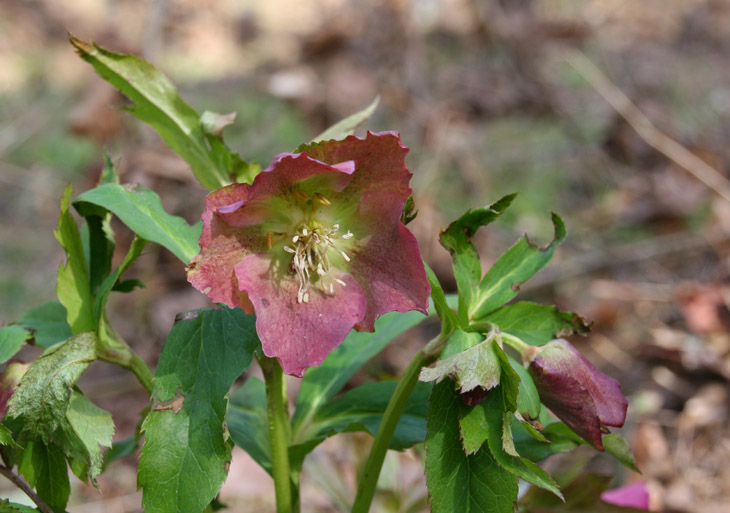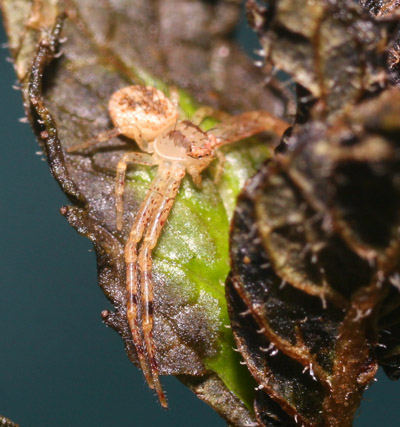No, not later in the century or anything – just later in the year, since mid-February is a tough time to illustrate Darwinism and natural selection, especially when it’s too damn cold to be out looking for photo subjects.

But yes, it’s Darwin Day again, and to honor it, I have just a couple of half-hearted images (until I decide to arbitrarily reassign Charles’ birthday to May or something.) In late January, in the sunny aftermath of the big east coast storm that caused only moderate weather in my area, I went out around the pond looking for items of interest. At too great a distance, I spotted what I suspected was a hawk sitting on the ground, and began switching lenses – not that it would have done much good, because the decent telephoto zoom was still sitting back at the house, but the wide-angle lens I had fitted certainly wasn’t going to work. Despite pausing some fifteen or so meters away, the hawk spotted me and decided discretion was better, and took to the trees, closely followed by another. From the size I suspected either red-tailed (Buteo jamaicensis) or red-shouldered (Buteo lineatus) hawks, but I didn’t have a good enough view to distinguish markings. Even as I crept closer, correctly surmising that they had only gone into nearby branches, I found that they had stayed in deep shade and didn’t present any better view, nor did they hang around as I got closer – this time, they took off across the pond while shielded from my view by evergreen trees, though I confirmed that the first one was carrying prey. I backtracked to where I had first spotted it and found the evidence, but not a rabbit or a vole as I had expected; instead, the feathers of what was likely a northern flicker (Colaptes auratus) provided the story. They also provided a probable identification of the raptors, since Cooper’s hawks (Accipiter cooperii) are the bird-hunters around here, only slightly smaller than the red-shouldered. Other hawks may snag birds as the opportunity arises, but more often as nestlings or fledglings, while the accipiters like the Coopers’ and sharpshin hawks can catch birds in flight. I’ve watched them in action, and they are blindingly fast and agile.
 A week later the last traces of the snow/sleet had vanished, and I was out with a student. We were both startled to find a local unidentified wildflower blooming vigorously despite the still-chilly temperatures and the constant mottled-shade that the location provided. The reds were so subtle they almost disappeared against the carpet of dead leaves, and it was the only example of that species seen in the area (or, to my personal recollection, at all.) Feel free to enlighten me if you can identify this.
A week later the last traces of the snow/sleet had vanished, and I was out with a student. We were both startled to find a local unidentified wildflower blooming vigorously despite the still-chilly temperatures and the constant mottled-shade that the location provided. The reds were so subtle they almost disappeared against the carpet of dead leaves, and it was the only example of that species seen in the area (or, to my personal recollection, at all.) Feel free to enlighten me if you can identify this.
 As is typical for NC, the temperatures bounced back into the high teens (or low sixties if you still use Fahrenheit) for a short while before plummeting again, which brought a couple of frogs out of my ornamental pond where I thought they’d be waiting out the winter. It also immediately flushed out the spiders, since I spotted three different species in one ten-minute session at night, including this little crab spider (genus Mecaphesa) alertly awaiting prey on a valiant mint plant – no, that’s not a species name, just the reflection of this particular plant which was still trying to remain green long after all of the spearmint plants had given up for the winter – hardy little cuss. As to how much food spiders can snag this early in the year, I can’t even speculate, but I do know that the compost bin had already started being raided by some minuscule insects, so they all appear to know what they’re doing.
As is typical for NC, the temperatures bounced back into the high teens (or low sixties if you still use Fahrenheit) for a short while before plummeting again, which brought a couple of frogs out of my ornamental pond where I thought they’d be waiting out the winter. It also immediately flushed out the spiders, since I spotted three different species in one ten-minute session at night, including this little crab spider (genus Mecaphesa) alertly awaiting prey on a valiant mint plant – no, that’s not a species name, just the reflection of this particular plant which was still trying to remain green long after all of the spearmint plants had given up for the winter – hardy little cuss. As to how much food spiders can snag this early in the year, I can’t even speculate, but I do know that the compost bin had already started being raided by some minuscule insects, so they all appear to know what they’re doing.
This image, by the way, was shot by flashlight, my bright little Cree jobbie – I already had it out mounted on a mini-tripod for use in silhouetting another spider under a leaf, and simply set it up aimed at the crab for a casual couple of frames before I went back in. Naturally, the crab shot came out much better than the images that I’d planned with the flashlight, but those were admittedly taken in a much more awkward position. Most of the frames from both subjects were tossed due to motion blur and being slightly off focus, the faint breeze and inability to stabilize myself contributing to no small degree. However, this image made it through the selection process, which brings us full circle to Darwin, so there.



















































